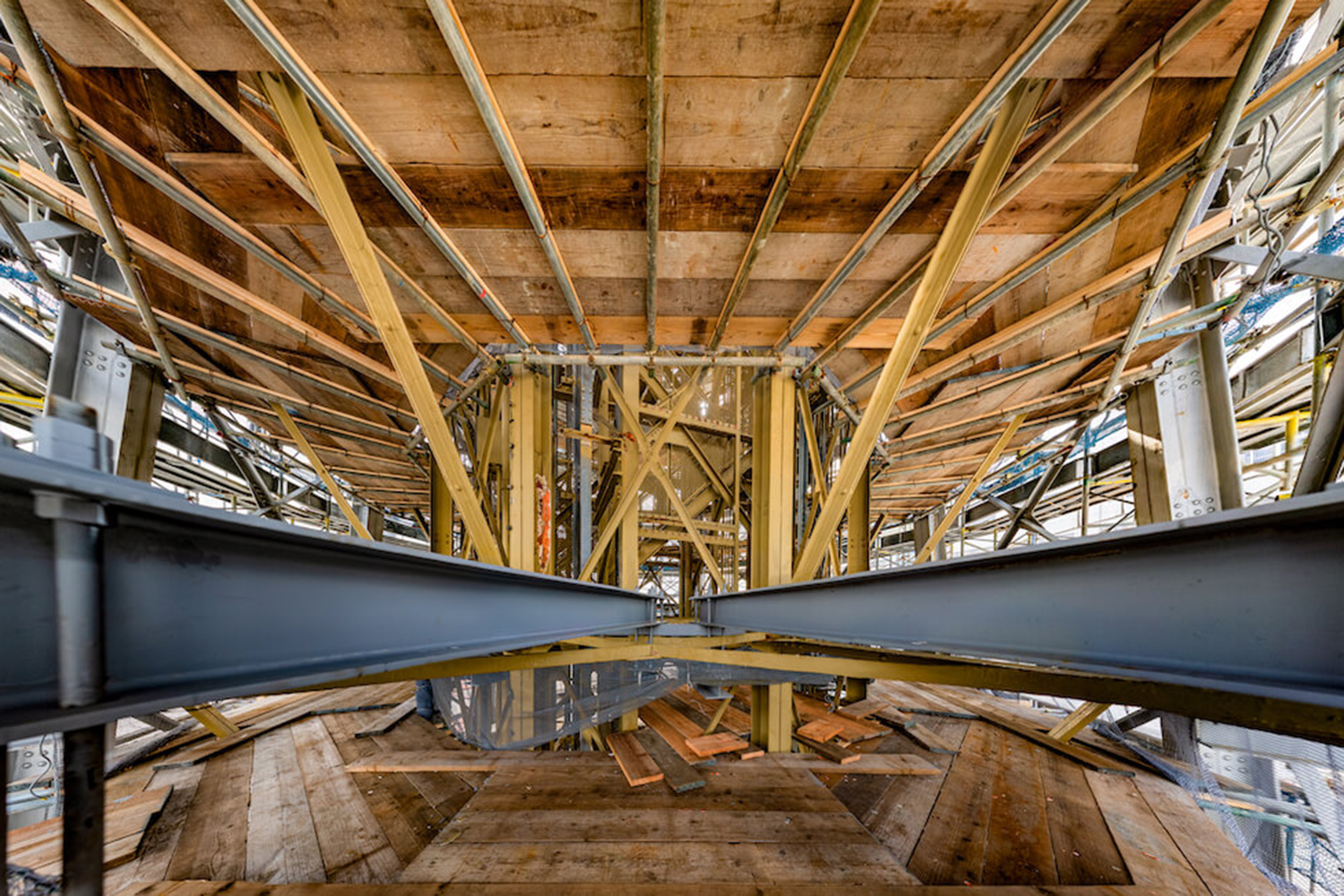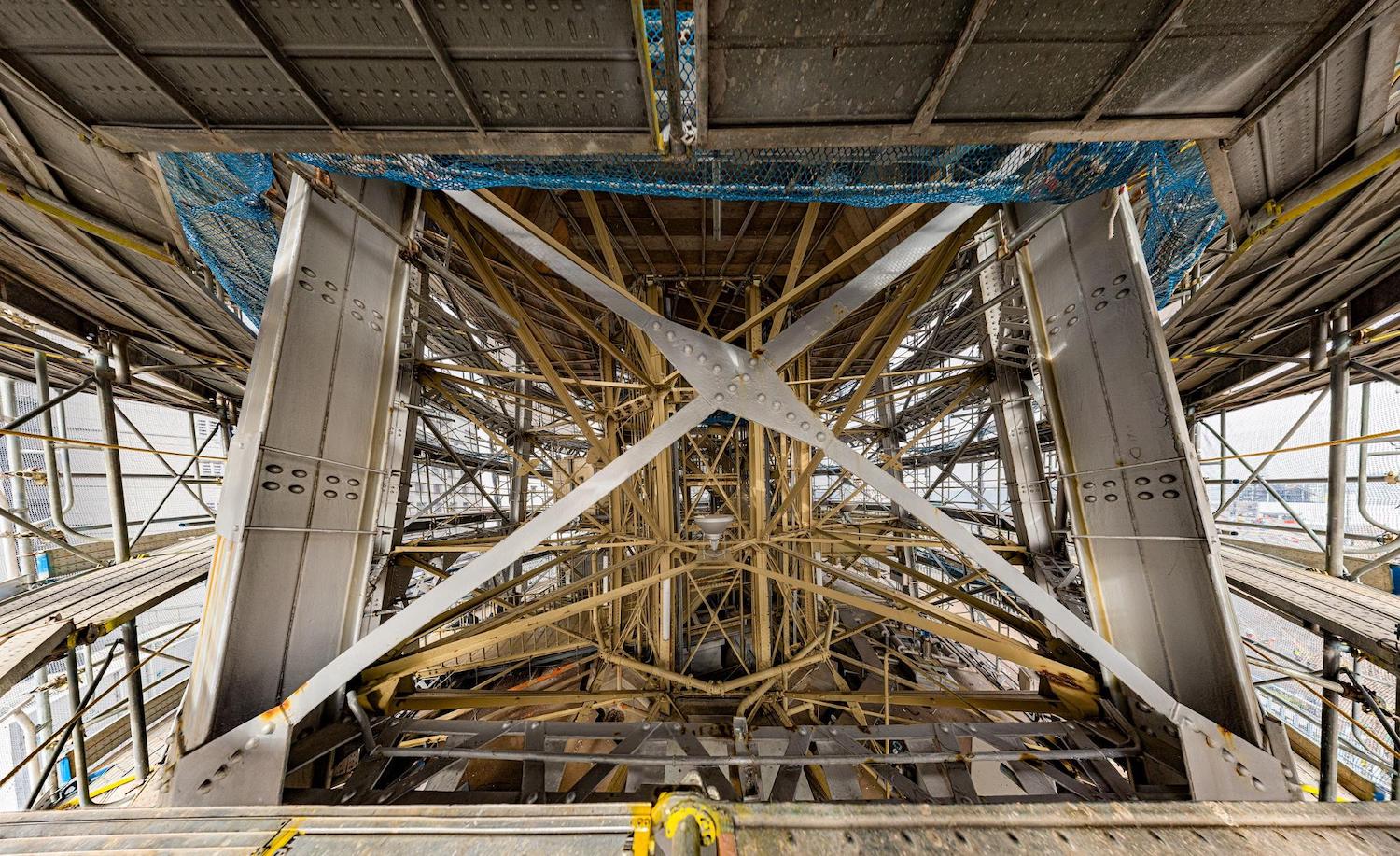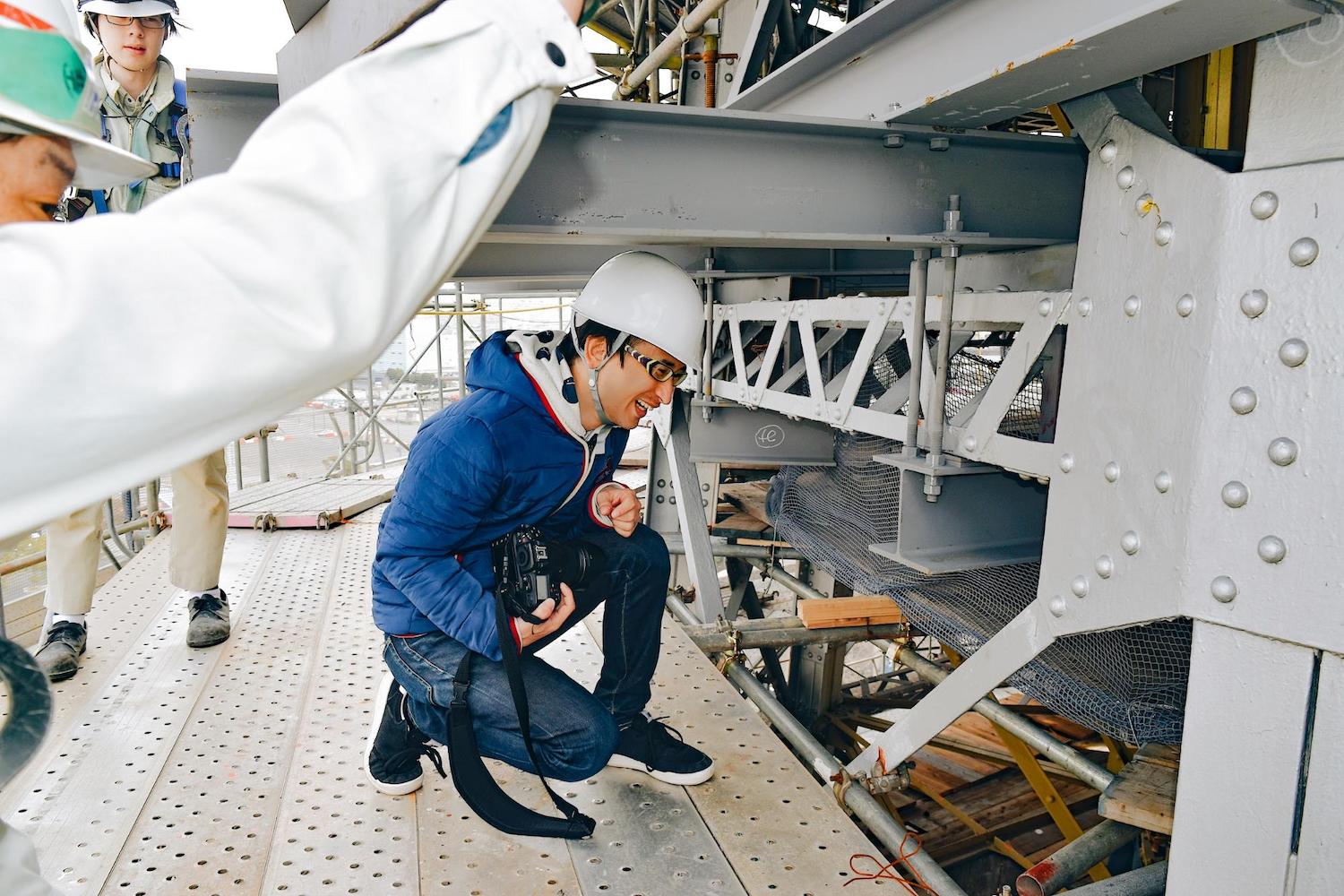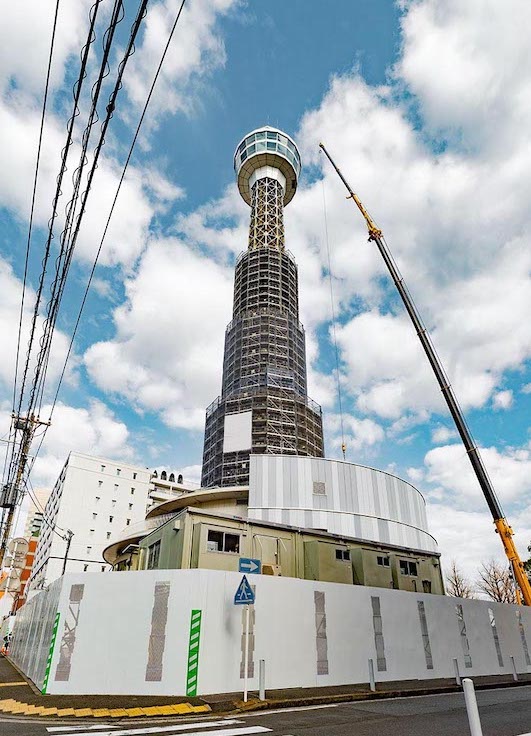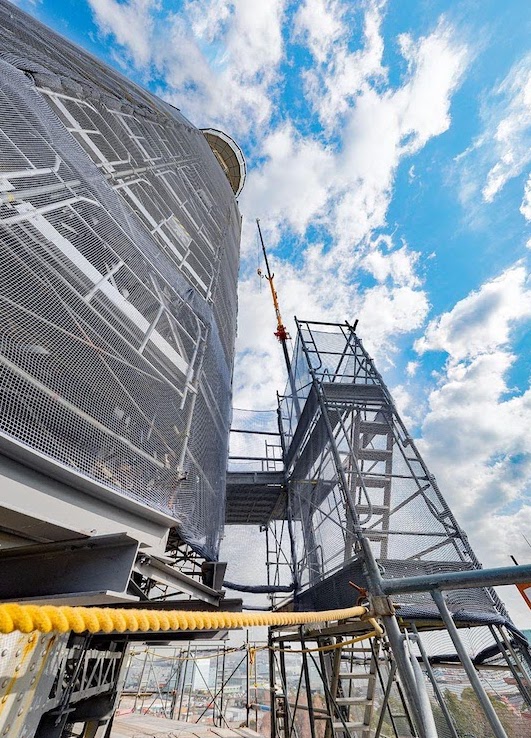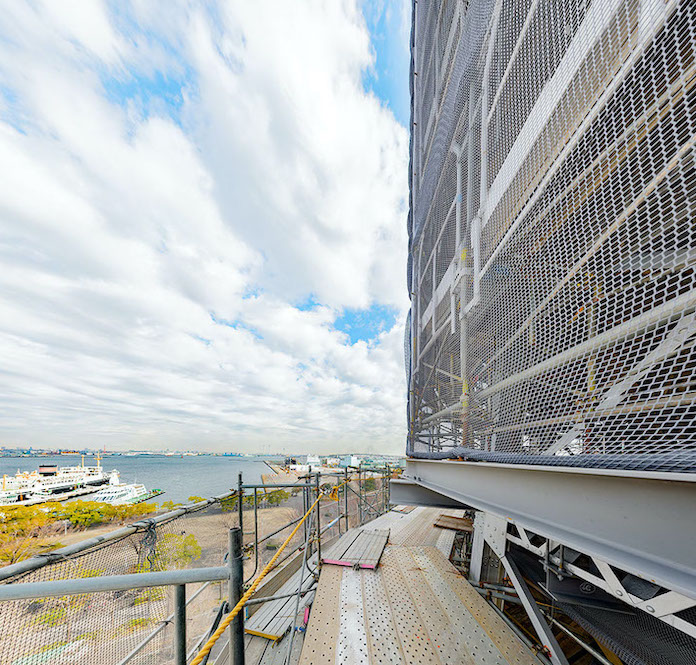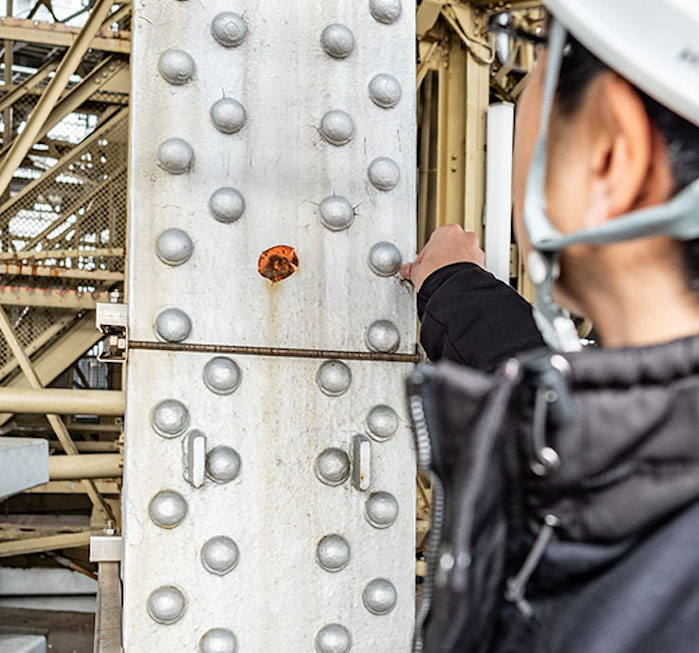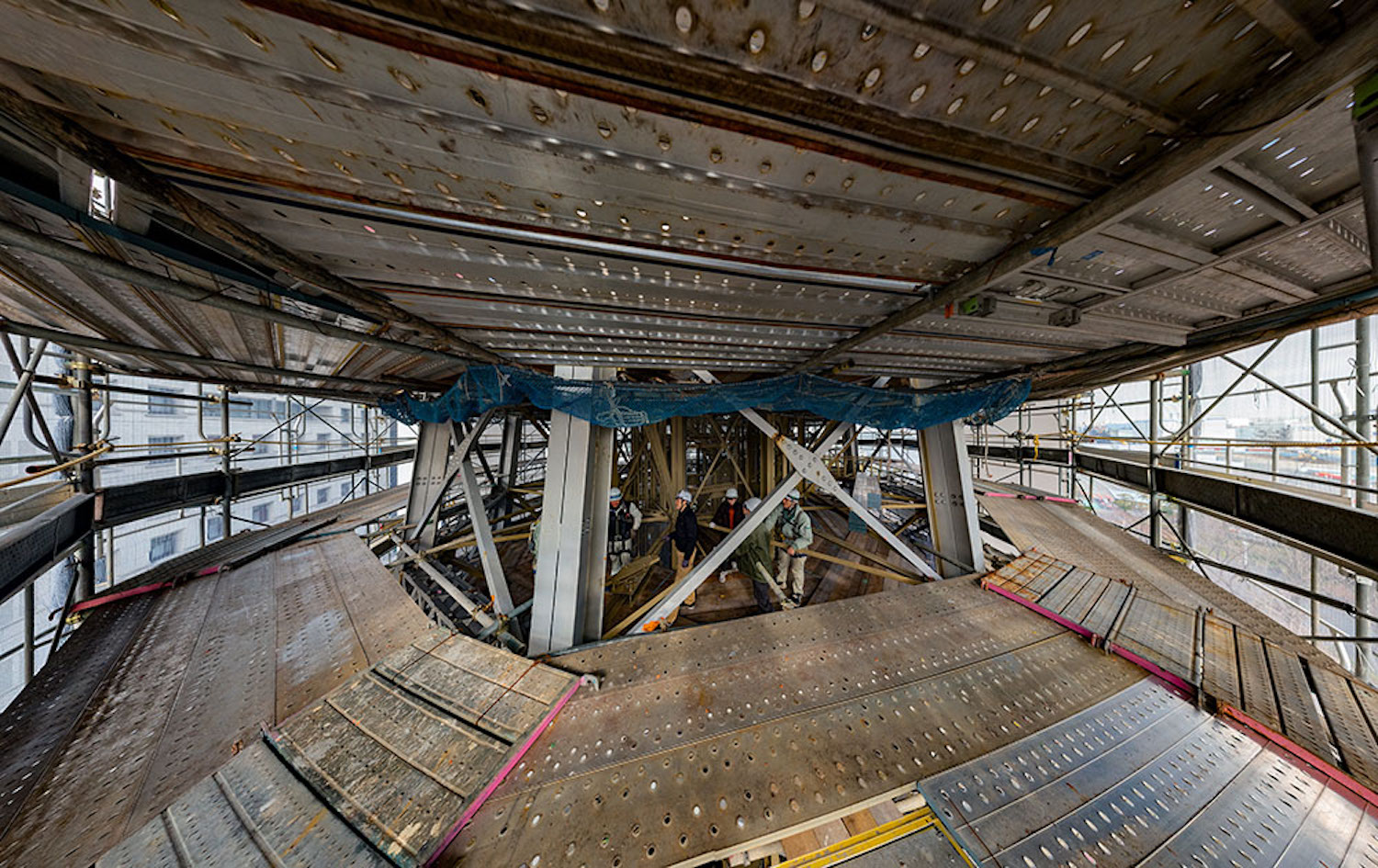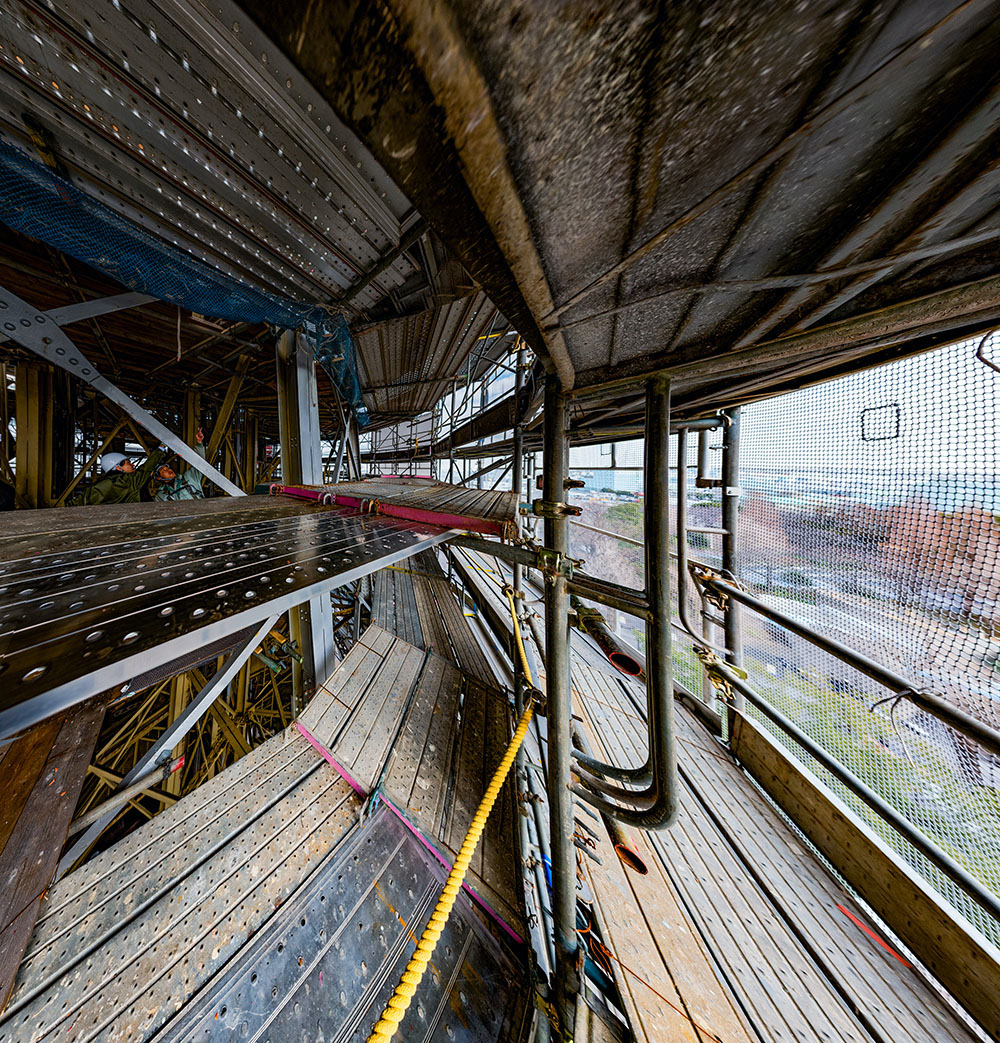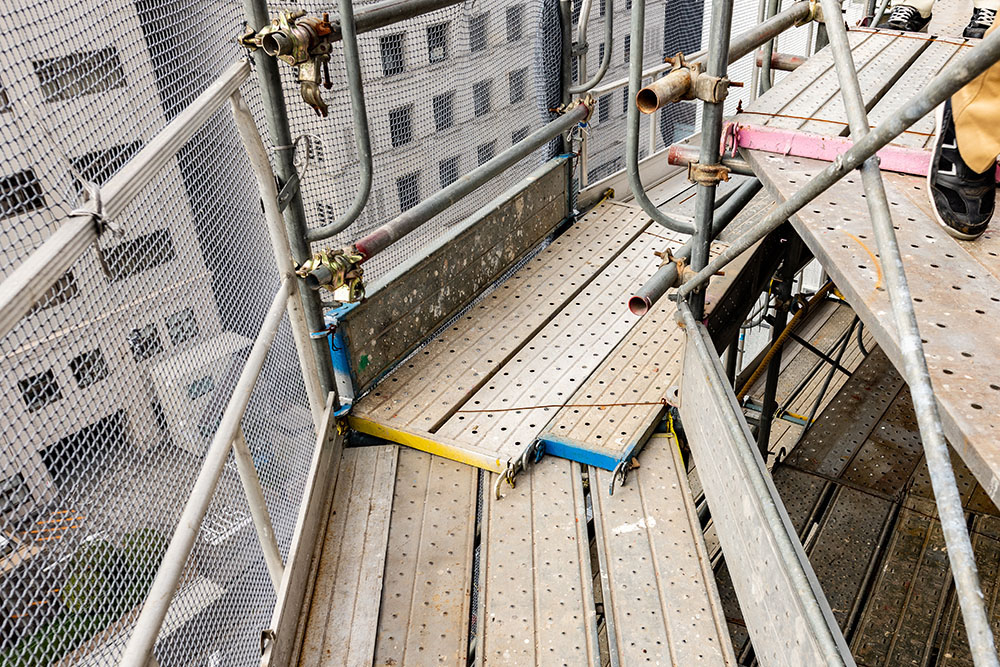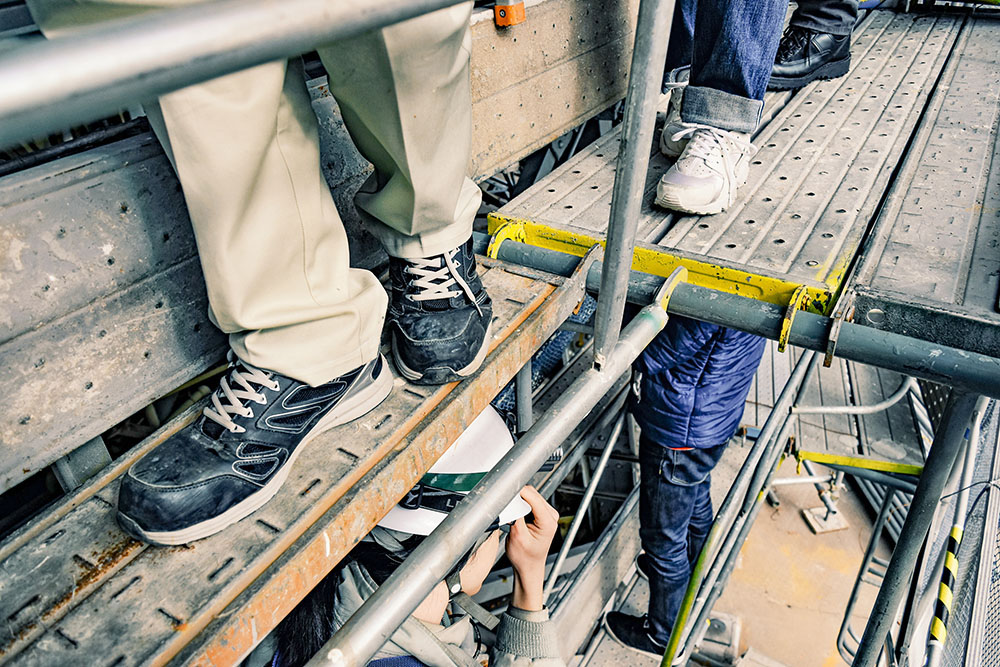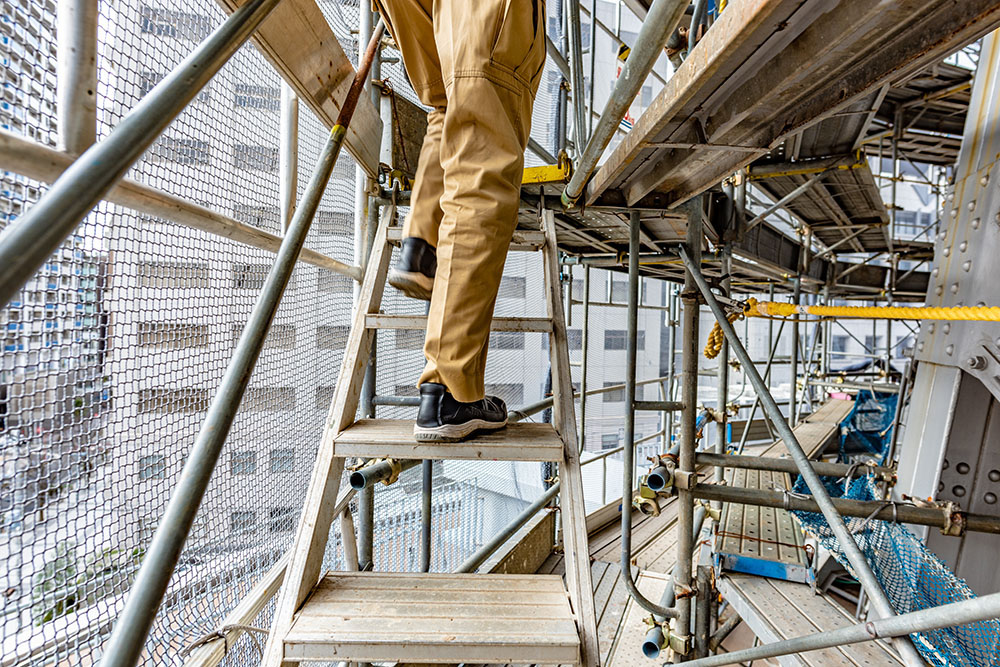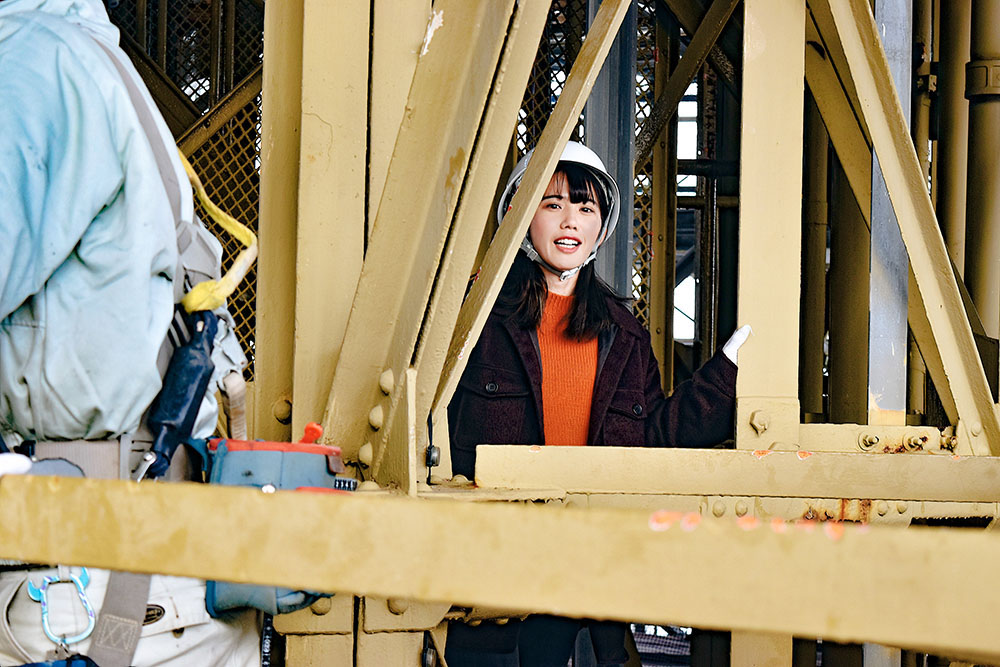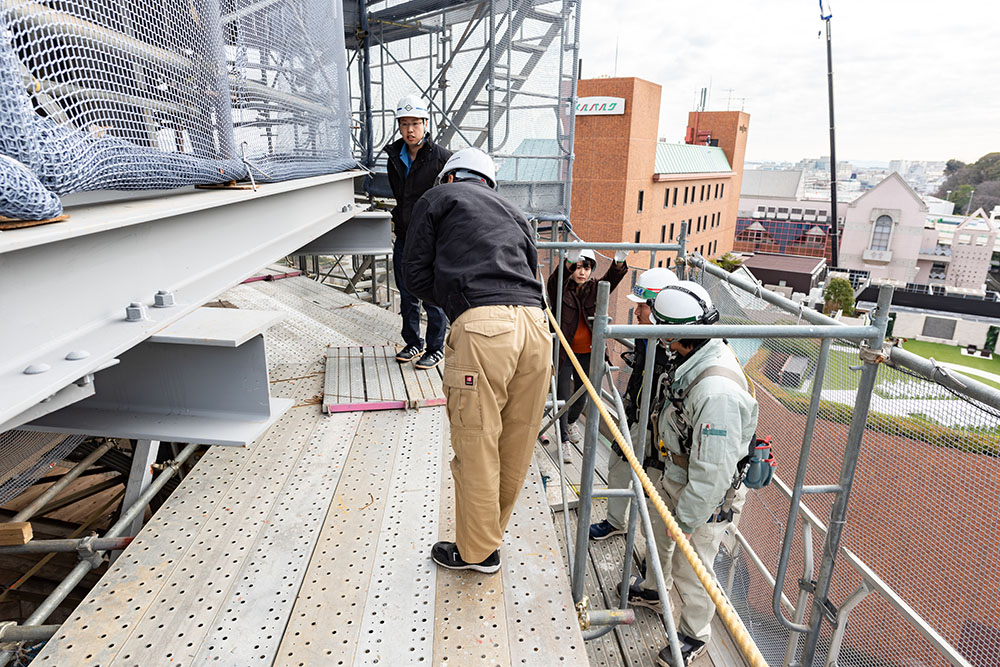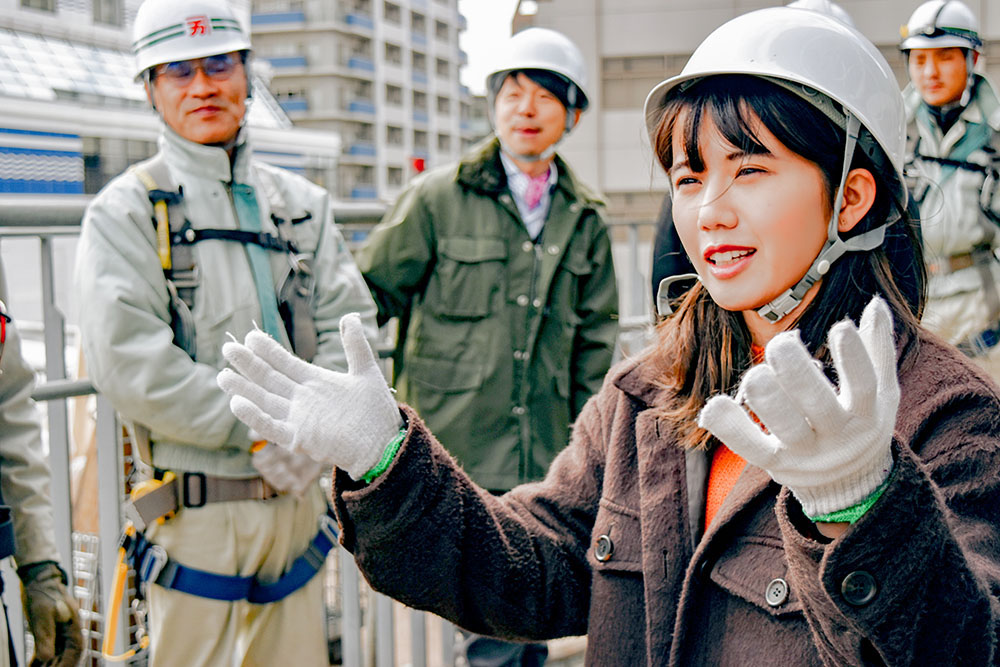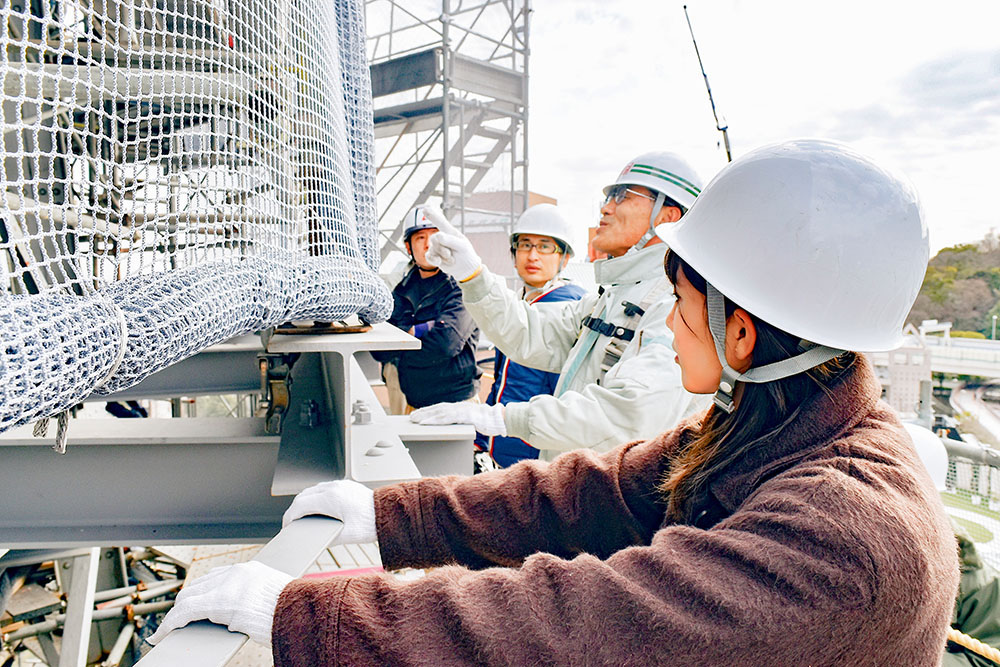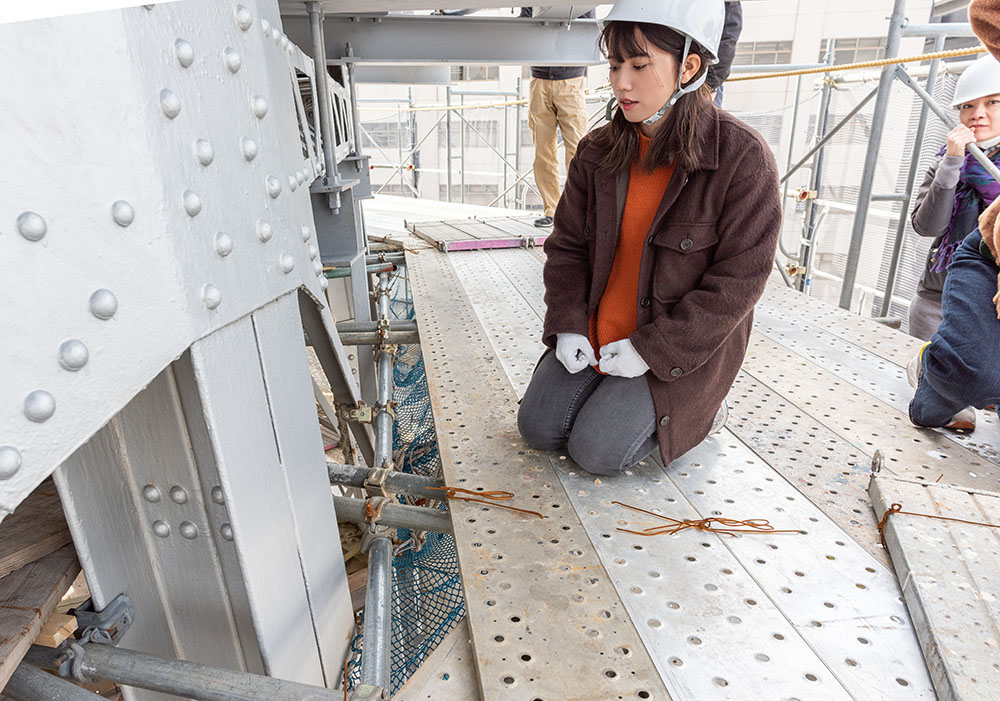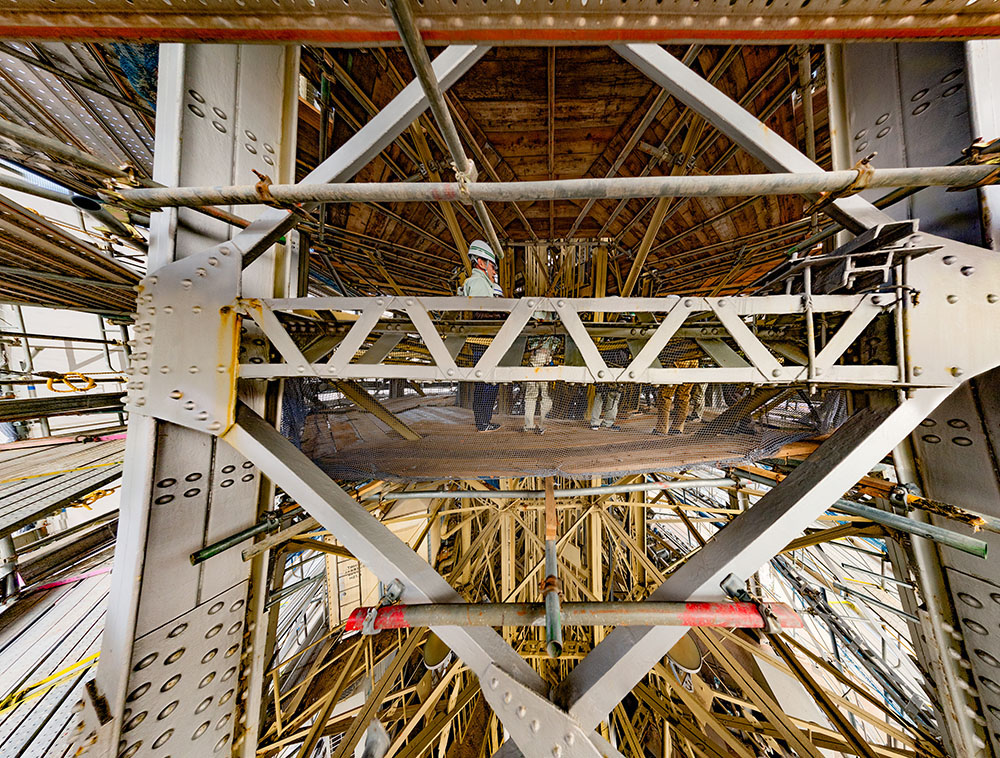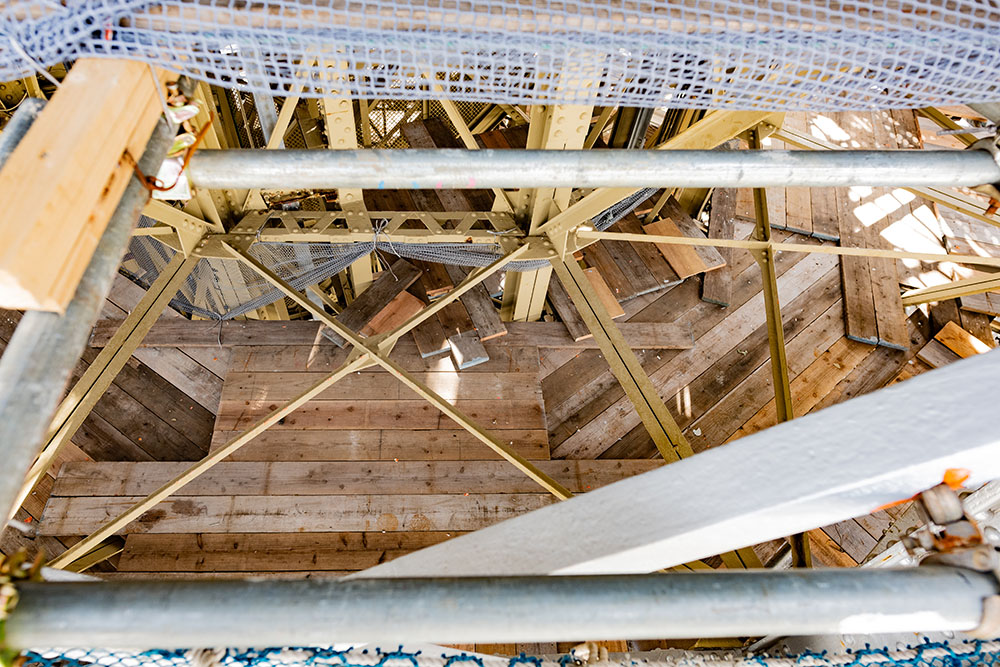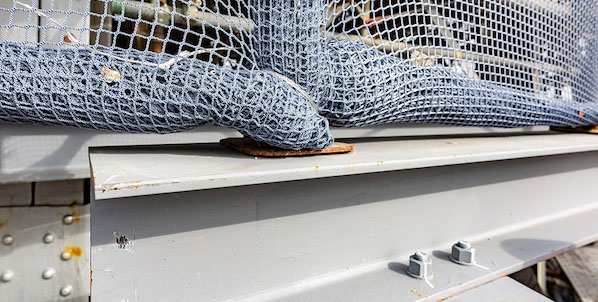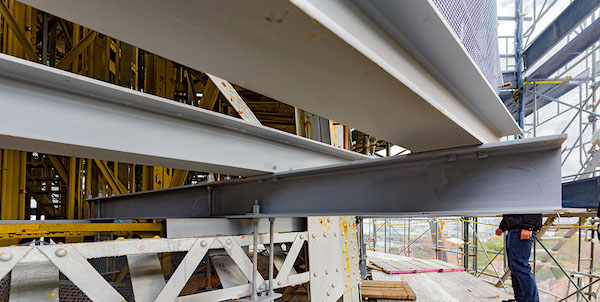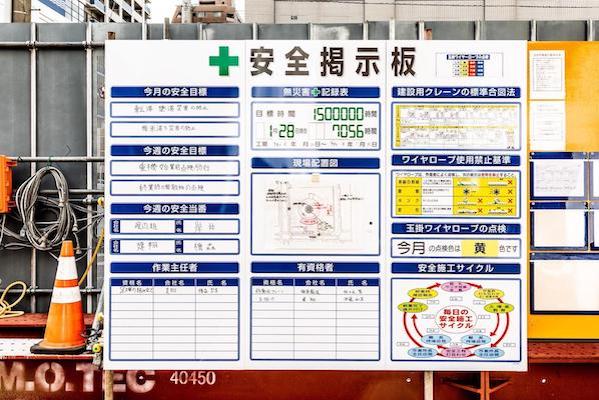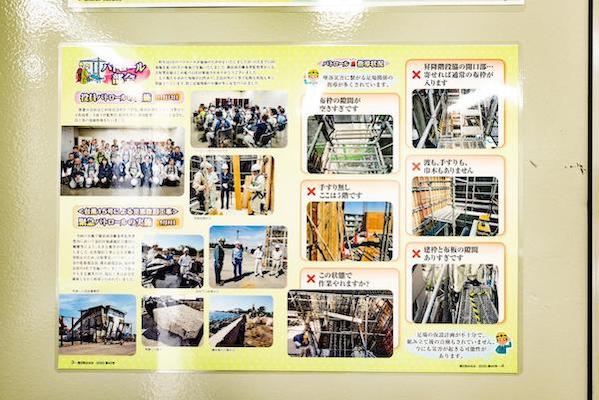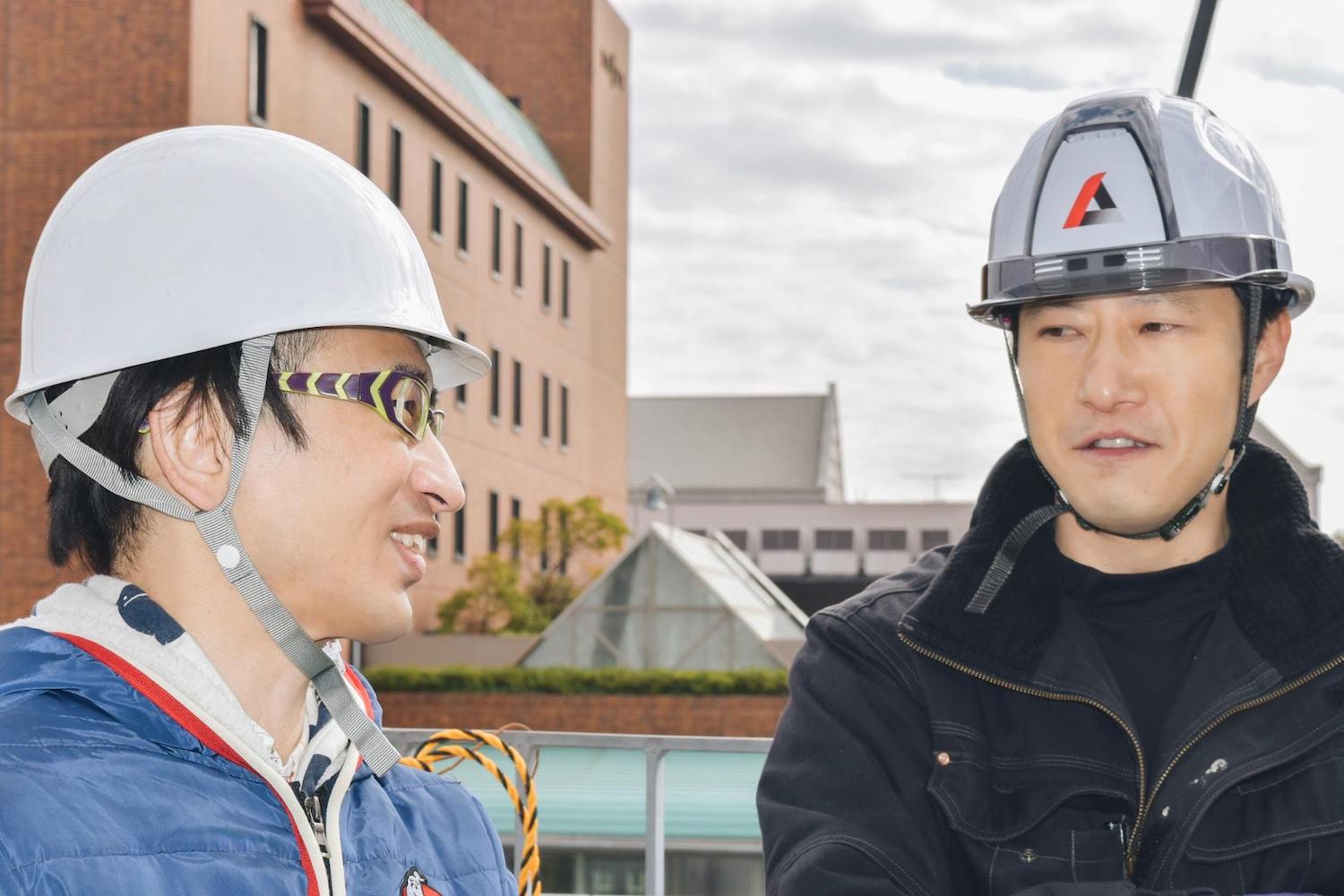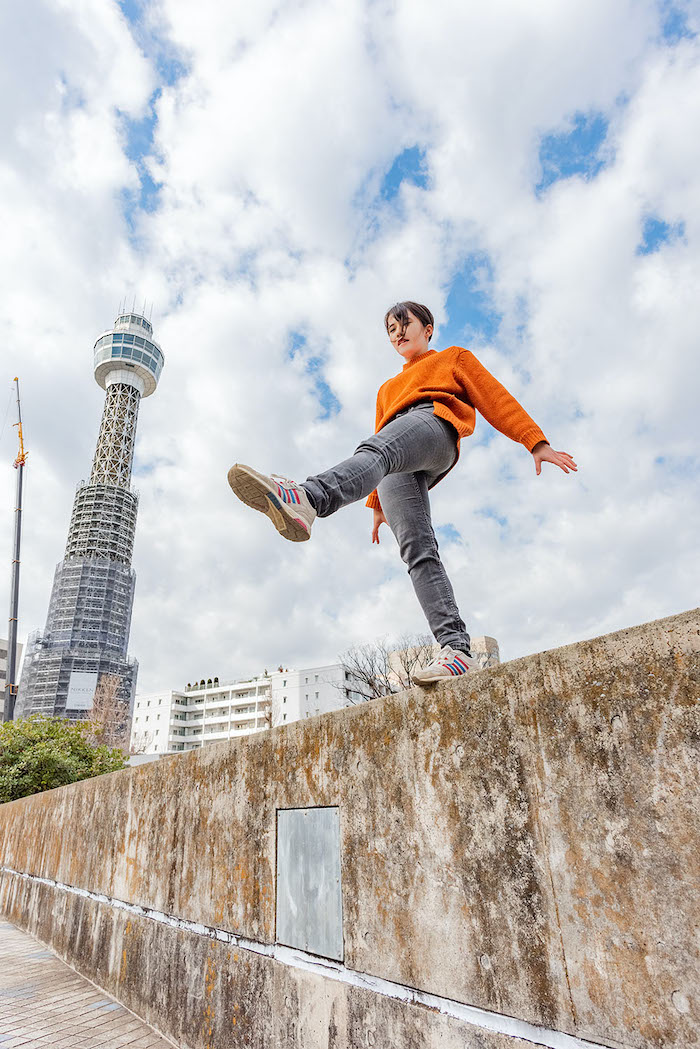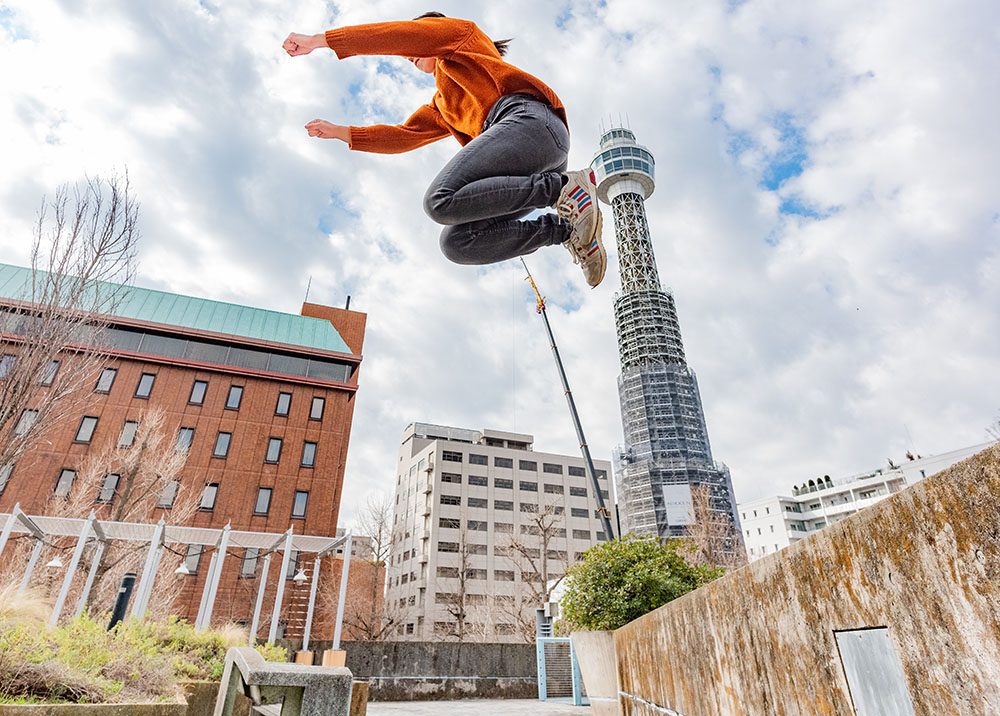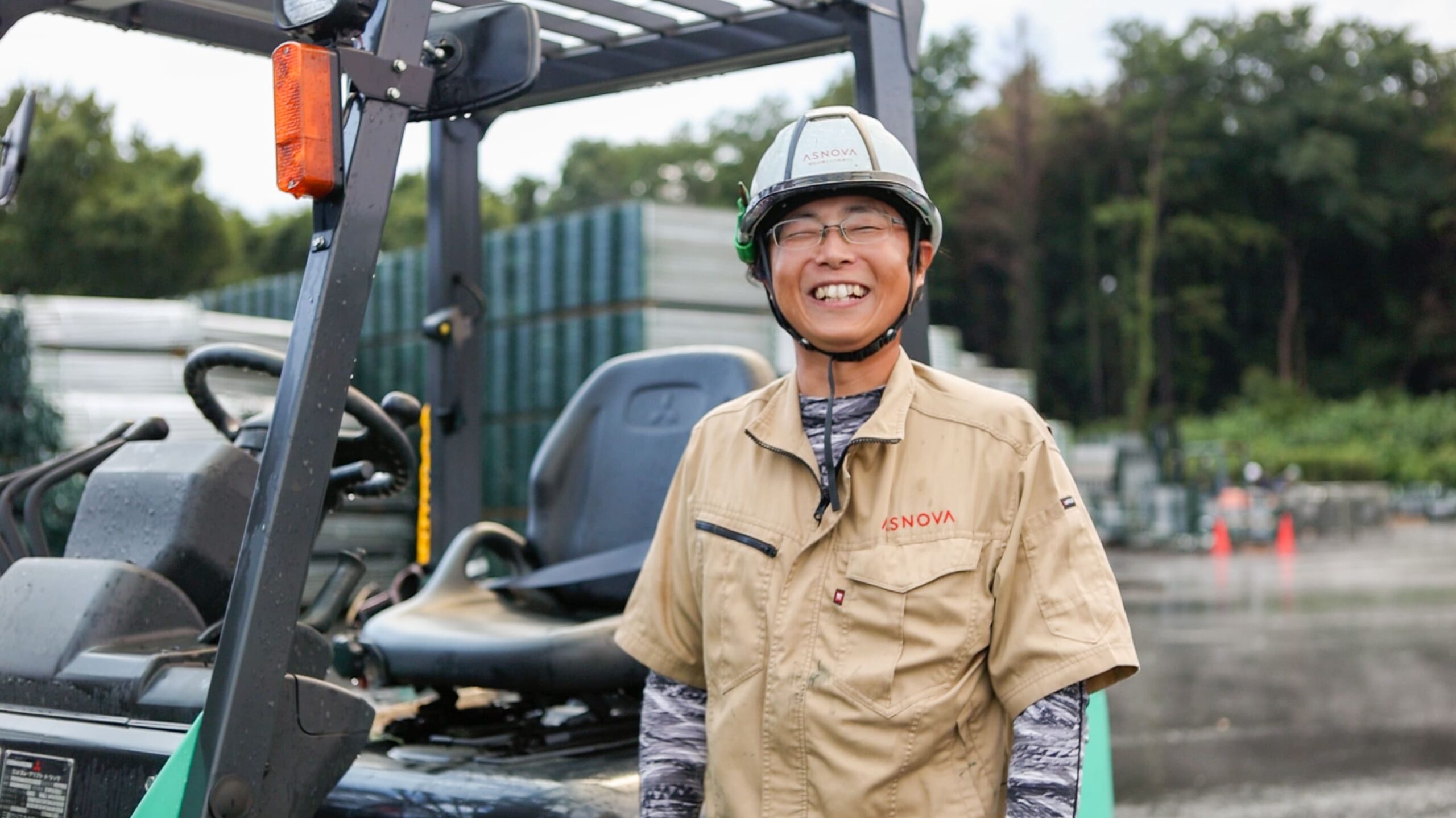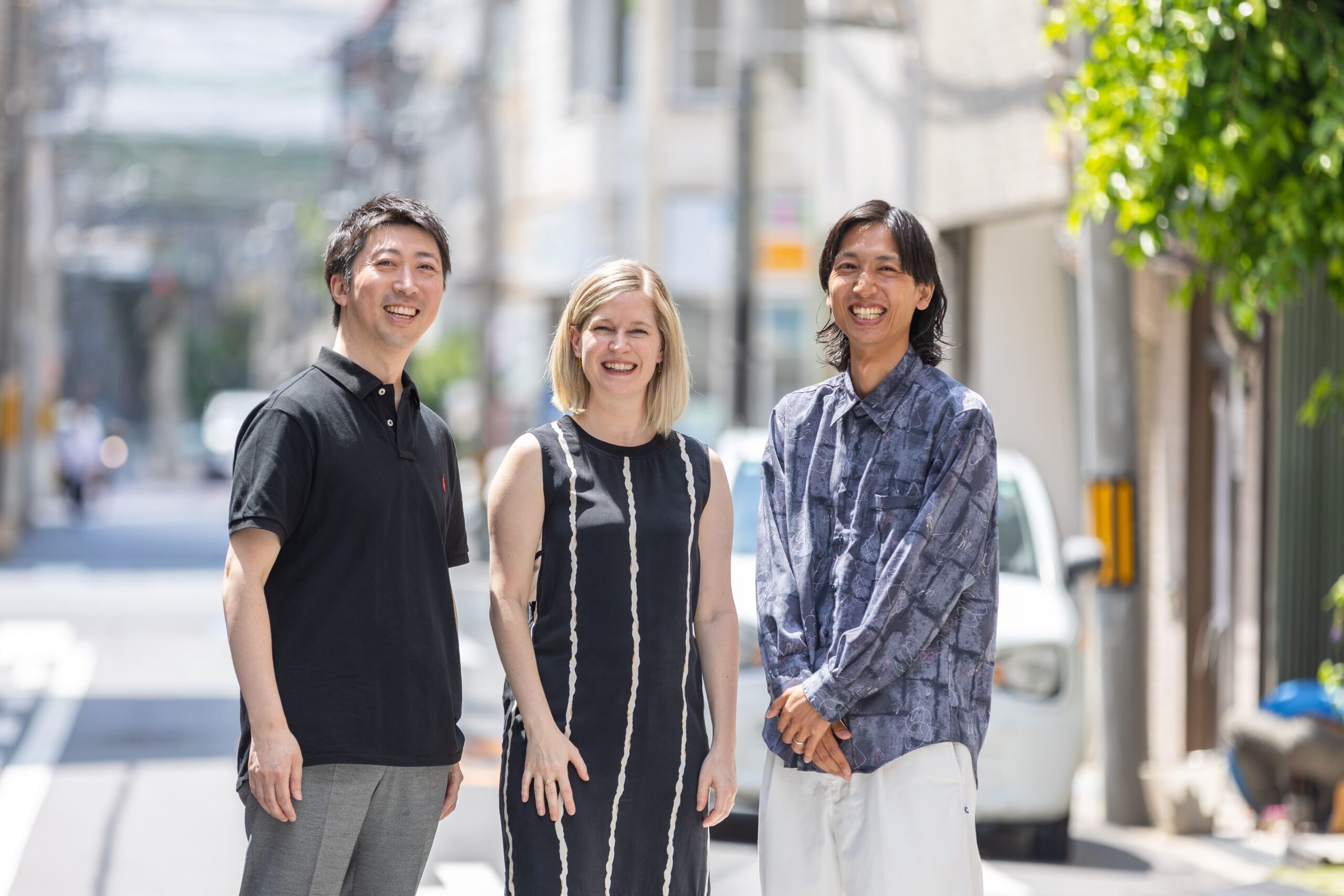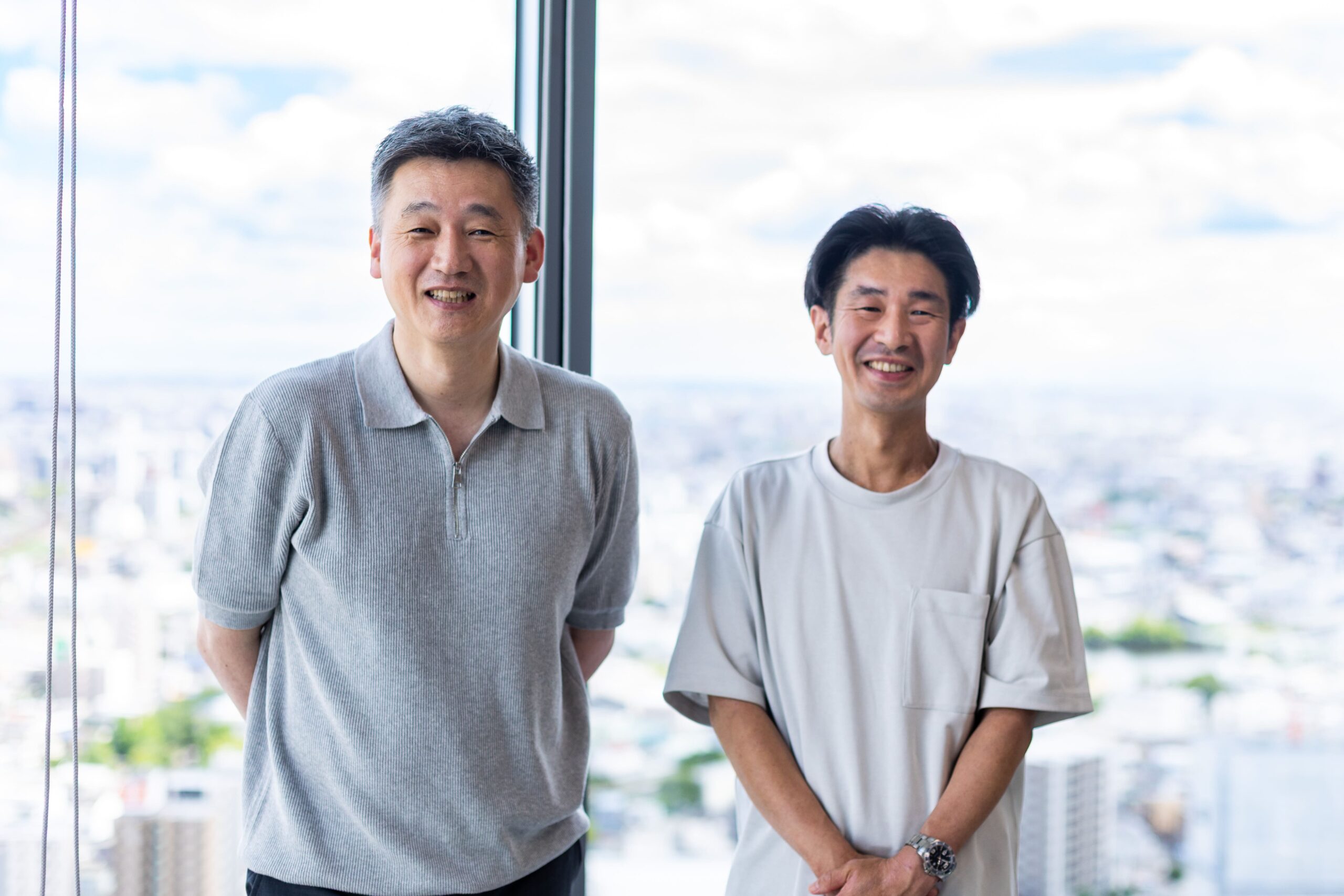スパイダーマンのクモ糸はどうなるのか
改修工事のために足場がかけられた横浜マリンタワー。地上十数メートル。本来、足場がなければ立つことができない場所だ。左右の丸いリベットが打たれた太い鉄骨とその内側のオリーブブラウンがマリンタワーの構造。その周りに張り巡らされているのが足場だ。(撮影:大山)
スパイダーマンのクモ糸は、発射された後どうなるのだろうか。ずっとそのままなのだろうか。悪漢の身体に巻き付いた糸はそれでもいいとして(よくないか)、ビルの外壁に粘着したものがそのままだとしたら、これはゆゆしき問題だ。かなり丈夫な糸なので除去するのも大変だろう。マンハッタンのビル外壁掃除に携わる方々の苦労がしのばれる。スパイダーマン専用洗剤とかありそうだ。クモ糸落とし「スパイダーウェブ・パーフェクト・オフ」とか。「外壁に優しいマイルドクレンジング。ぬれた手でもOK」」とか。
一体何の話だ、とお思いだろう。足場の話である。先日、改修工事中の
横浜マリンタワー におじゃまして、足場をじっくり見せていただいた。その際にふと思ったのが
「足場ってスパイダーマンのクモ糸に似ている」 ということだったのだ。ことだったのだ、って言われても相変わらず何の話だ、という感じだろう。順を追って説明するのでどうかついてきてください。
工事関係者のみなさんに解説を受けながら足場を愛でるぼく。ものすごく楽しかった!(撮影:酒井さん)
ぼくは以前からずっと足場に魅力を感じていた。知人にも足場好きが多い。「足場って良いよねえ」 と言えば「そうだよねえ」と当たり前のように返してくる友人ばかりなので、「足場趣味」のたしなみ は常識のように感じていたが、冷静に考えてみればそんなわけはない。同じ価値観のコミュニティ内でやりとりしていると視野が狭くなる、というのはこういうことか。いわゆる「フィルターバブル」である。いちいち説明しなくても分かってくれる知り合いばかりだったため、真剣に「足場の魅力とはなにか」 を考えたことがなかった。そこで今回、改めて実際の足場を見学し、それを言葉にしようと思い立った。そこでおじゃましたのが横浜マリンタワーというわけである。
塗装を全部やり直す マリンタワーの工事
何はともあれ、まずは今回見学させてもらった横浜マリンタワーの工事について説明しよう。
山下公園の横に立つ横浜マリンタワーは横浜港開港100周年を記念して1961年に完成した。展望台部分が10角形というキュートなタワー である。106メートルで、展望台のほか灯台としても機能していた。現在は灯台の役目は終えて、もっぱら展望、イベント、商業施設として活躍している。このタワーが現在改修工事中で、その様子を見せてもらったわけだ。もともと民間事業者のものだったが、2007年に横浜市が取得、市による改修工事を経て、2009年5月にリニューアルオープンしている。
取材時のマリンタワーの様子。魅力的に足場に囲われている。全体の3/4の足場ができあがった段階。タワーが上に向かってすぼまっている。今回おじゃましたのは一番下の段まで。全体の1/4のあたりまでだ。(撮影:大山)
100トンクレーンを使って足場を持ち上げ、組んでいく。考えてみれば、足場を組むための作業自体が足場の上で行われるわけだ。(撮影:大山)
このマリンタワー、現在は休館中である。施設部分のリニューアルに加え、外側の塗装を塗り直すという工事を行うからだ。「建設以来、痛んできたら上から塗装を塗り足すというやり方でしのいできたんですが、下地がもう限界ということがわかりまして。塗りが厚くなりすぎて剥がれ落ちかねない状態なので、すべて剥がして塗り直します」と横浜市観光局。塗装はウナギ屋の秘伝のタレとは違って、創業当時からの継ぎ足しで価値が出るというものではない のである。タワーを支える構造部分の塗装を全部やり直すのだから、大がかりな工事になる。再オープンするのは2022年である。取材・執筆現在はまだ足場を組む作業中の段階であった。
足場の上からは山下公園とその向こうの港がよく見えた。(撮影:大山)
1961年から実に60年弱に渡った厚化粧もそろそろ限界。足場に乗って近くで見ると、その様子がよく分かる。(撮影:大山)
足場を組むための作業自体が足場の上で行われるわけだ。
大山
泉ひかりさん=スパイダーマン
それにしても、横浜市の担当者さんと工事を手がける渡辺組の方々にご案内いただいたのだが、まさか天下のマリンタワーを「足場を見たい!」と言って訪ねてくる人がいるとは思わなかっただろう。工事中で足場が組まれているものなら日本中にいくらでもあるだろうに、なぜわざわざ横浜マリンタワーなのか。
写真をご覧頂ければその理由が分かると思う。第一に、なんといってもタワーにかけられた足場というのが珍しい 。そして第二に、円筒形の構造物に組まれた足場というものをぼくが見たことがなかったからだ。ぼくはこれまでたくさんの工事現場を取材してきた人間なので、普通の人よりは「足場慣れ」 している。それでも今回のような円形に組まれた足場は体験したことがなかった 。とてつもなくかっこよかった。興奮した。
タワーの構造物を囲むようにぐるりと円く足場が組まれていることが分かる。ここは今回登らせてもらった部分の一番上エリア。およそ地上20m。(撮影:大山)
当然足場部材は通常の真っ直ぐなものを使う。その結果、こうやって多角形にかくかくと曲がった足場空間ができる。こんな足場は今まで見たことがなかった。(撮影:大山)
などと喜んでいるぼくだが、一方、実際に足場を組んでいる渡辺組の方からすれば、やや特殊な現場にぼくのような素人を案内するのに若干の危惧があったのではないか。
事前の説明で「通常でしたらがっちり組まれる「つかみ金具」が出ていますので、注意してください」と念を押された。もともと運動神経が良くない上に興奮状態のぼくなどはたいへん危険だ。
このように通常がっちり組まれる足場が、やむなく斜めに置かれることになる。浮かれてつまずかないように気をつけよう。(撮影:大山)
そうでなくても、足場を行くのには慎重さが求められる。ほんとうに浮かれないように気をつけよう。(撮影:酒井さん)
階段もこの通り。当然だが足場の階段というものは、ふつうの建物の階段のように快適にはできていない。感覚としてはハシゴに近い。(撮影:大山)
しかし、ぼくと同じ工事現場の素人でありながら、まったく危なげない方が一人いた。
それが今回の取材のいわば「ゲスト」である、
パルクールアスリートの泉ひかりさん だ。身体ひとつで道具を使うことなく建物や壁などをひょいとジャンプし走り抜ける、あのかっこいいパルクールである。リュック・ベッソンの映画『YAMAKASI』で知った方も多いのではないか。
パルクールにうってつけのタワー構造物の中で楽しそうな泉ひかりさん(足場の写真撮るのに夢中になって泉さんのまともな姿の写真を撮るのを忘れてました。すみません)(撮影:酒井さん)
ぼくはおっかなびっくりへっぴり腰だったが、泉さんは余裕の身のこなし。さすがだ。(撮影:大山)
なぜ泉さんにおいでいただいたのか。
それは「足場趣味」のぼくが感想を書き連ねるだけでは良い記事にならないだろうと思ったからだ。先ほど言った、同好の士たちの内輪ノリの内容になりかねない。ほどよい「オブザーバー」が必要だ。そこで本記事の編集さんが白羽の矢を立てたのが泉さんというわけだ。
この人選はほんとうにすばらしかった。ぼくと同じような「足場趣味」の人ではダメだが、全くの「無理解者」でも困る(本人もつまらないだろうし)。良き「理解者」であってほしい。そんなぜいたくな要望にうってつけの方だった。きけば、お父様は建築関係のお仕事をなさっていて、足場も見慣れたものだったという。いちばん「へー!」と思ったのは「わたしたち、練習のために単管パイプ組むんですよ」 という説明だった。いま書いていて思ったが、ぼくよりよっぽど足場慣れしている ではないか。ともあれ、ぼくは今回、泉さんの目を通して新鮮な気持ちで足場を見ることができた。その結果が冒頭で言った「足場ってスパイダーマンのクモ糸に似ている」 という発見である。そして同時に「泉さんはスパイダーマンだ」 と思った。
「練習のために単管パイプ組みます」という話にはおどろいた。また「安全が第一だという点では鳶の方々もパルクールも同じです」と強調なさっていたのに、たいへん感心した。ほんとうに泉さんが同行してくれてよかったと思った。(撮影:酒井さん)
わたしたち、練習のために単管パイプ組むんですよ。安全が第一だという点では鳶の方々もパルクールも同じです。
泉
身体を使って都市を「見る」
「泉さん=スパイダーマン説」の説明のために、すこし話を遠回りしたい。
ぼくは建造物を専門に撮る写真家である。特に土木構造物や工事中の様子を写真に収めてきた。『工場萌え』 なんていう写真集も出したことがある。学生時代には都市デザインを学んでいた。
ずっと「都市をどう見るか」 に興味がある。写真に撮ることで、肉眼では見えなかった建造物の姿を「見る」ことができる。
良い風景を前にしても「映える」写真を撮ることに夢中になってちゃんと見ていない人が多い、と嘆くのをよく耳にする。これはカメラやスマホが見ることをスポイル、という昔からある考えだ。
これは大間違いである。写真によってよりよく見ることができるのだ。ぼくがかつて建築家に憧れ、常に尊敬を抱いている理由は、彼らが独自の目を持って都市を見ることができる からだ。建築家が見ている風景は、ぼくらのそれとは違う。おそらく、同じように、イラストレーターは描くことで、詩人は詠むことで風景を発見する。彼らの手と言葉はある意味「第三の目」なのだ。そしてパルクールアスリートにとっては身体が「目」 なのだと思う。
(撮影:酒井さん)
泉さんが鉄骨や足場に触れたり、ぼくがとらないようないろいろな姿勢で足場を体験している様子が印象的だった。(撮影:大山)
泉さんは決して饒舌な方ではなかったが、彼女の動きを見ていると、足場が組まれているマリンタワーを「見て」いる ことがわかった。ちょっとした手や足の動き、体重のかけ方などが、ぼくを含めた他の人たちと全然違う。まるで足場や構造物の表面を愛でている ように見えた。ぼくがそう言うと泉さんはうなずきながら「例えば跳ぶときは、靴の裏で表面の具合を確かめたりするんですよ」と教えてくれた。
そうなのだ。彼らは構造物の形や高さだけでなく、テクスチャを読むことに長けているのだ。写真も「表面を見る」装置だが、泉さんたちは身体を使ってそれをやる。うらやましい、と思った。この思いを感じたことが、今回の最大の収穫だった。子供のころから身体を動かすのが苦手で、最近は四十肩にもなやまされているというていたらくのぼくにとってパルクールほど縁遠いものはないが、実は「都市を見る」という共通点があった のだ。
外周にめぐらされた他に、なんと構造の内側にも足場が組まれている。一同が立っているのがそこだ。当然ここは足場がなければ立つことができる場所ではない空中だ。(撮影:大山)
印象的だったのは、構造の内側にかけられた足場板は木製だったこと。「組立時の材料加工が容易なためです」とのこと。(撮影:大山)
言われてちゃんと見てみれば、足場はタワーの構造を借りて立っているのだった。この点もふつうのビルと違う点だろう。最終的に相当の重さの足場がタワーによりかかるわけで、それに耐えられるかどうかの構造計算がなされ、足場が組み立てられている。(撮影2点:大山)
写真にあるように、マリンタワーは普通のビルなどと違って、いわゆる外壁に覆われているのではなく、鉄骨の構造がむき出し だ。そこに足場が組まれてると、どちらがタワーの構造でどちらが足場かぱっと見区別がつかない風景が出現する。これが最高におもしろかった。まるでタワーの外側にもうひとつタワーが出現したかのよう だ。しかしよく見れば、とうぜんタワーの構造と足場は全く違う。当たり前だが、タワーの鉄骨は人がそこを行き来することを想定していない。だから平らな面がないし、スケールが人間のものではない。このことに気づいたとき、ぼくは発見した。足場の魅力とは、建造物を人間のスケールに分解する点にある 、ということだ。これはこの記事の結論である。
足場の魅力とは、建造物を人間のスケールに分解する点にある
大山
足場とはスパイダーマンのクモ糸
建造物は、そこで人が活動するためのものであっても、外からの見た目は、多くの場合人間のスケールから逸脱する。マンションやオフィスビルは、内部空間こそ人間のスケールに合わせて作られているが、外観はそうではない。マリンタワーのように、一番下の部分と展望台部分以外の間の大部分が、人間の大きさと関係ない場合はなおさらだ。灯台という機能は人間の身体の大きさと関係が無いので、下から姿を見たとき「ただでかい」ようにしか見えない。しかし、
そこに足場がかけられたとたん、人間の大きさとの比較がなされる 。足場は建造物に当てられた定規のようなものなのだ。建造物の見え方が一気に変わる。たぶん建築家は足場がなくても同じように大きさを把握できるのだろう。
そしてパルクールアスリートのみなさんがやっていることは、人間のスケールから逸脱してしまった建造物や都市を、身体に取り戻す行為 なのだ。足場がなくても、泉さんは構造物の鉄骨の間を自由に行き来することができるのだろう。きっと離れた鉄骨の距離を見て「ここからあそこぐらいまでなら跳べる」というようにこの風景を見ているに違いない。それはぼくとも建築家とも違う構造物の見方だ。実際、鉄骨に触れながらちょっとうずうずしているように見えたので「鉄骨登りたいですか」と言ってみたら笑顔で「跳びたいですねえ!」とおっしゃっていた。もちろん許されることではないが、足場の外れたマリンタワーの構造物の中を飛び回る泉さんの雄姿を見てみたい。その行為は、大げさに言えば一種の「建築評論」なのではないか 、と思った。
さて、ようやく冒頭のスパイダーマンの話だ。ぼくは、かねてからスパイダーマンのマンガや映画は優れた「都市評論」なのではないかと思っていた。マンハッタンが舞台の映画やドラマでは、上から街を眺めたシーンが必ずでてくる。あの街は高いところから見て初めてよく分かる街だということは、あの街に行ってみてぼくも実感した。地面を歩いていると、深い谷の底にいるようで街全体を想像するのが難しい。碁盤の目に整えられているので通りの形も画一的。もちろん様々なデザインのビルがあるのだが、どれもあまりにも高層で、地面のレベルからそれを確かめるのは難しい。
マンハッタン、と聞いて人々が思い浮かべる風景はハドソン川あるいはイーストリバーを隔てて遠くから見たものか、そうでなければ空撮だろう。要するに高いビルがみっちりと建ちすぎているので、離れて見なければわけが分からない街なのだ。街の中にいて距離を保つには上空に上がらなければならない。それこそスパイダーマンの視点なのである。つまり、スパイダーマンの視点と活動はニューヨークがどういう街であるかをよく表している。ぼくがスパイダーマン作品を「都市評論」と言うゆえんである。
建築家のジン・ヨハネスも「スパイダーマンは建築家!」と題して2007年公開の映画『スパイダーマン3』を評論している。曰く「クモの糸による放物線が描く目線による「都市の動き=Moving City」の描写がすばらしい。新たなマンハッタンの都市論をクリエイトしている 技法と言ってもいい[……]これは、そういう意味で建築家としての帰着原点の神髄と言える傑作です*」と。
足場とはスパイダーマンのクモ糸だ。そして泉さんは自分の手足を足場にして跳び、建造物と都市を「見る」のだ。「泉さん=スパイダーマン」とはそういうことである。
*ジン・ヨハネス「スパイダーマンは建築家!」、ディーテイル・ジャパン別冊『映画の発見!』収録、リード・ビジネス・インフォメーション株式会社、2008年、44ページ
クモの糸による放物線が描く目線による「都市の動き=Moving City」の描写がすばらしい
ジン・ヨハネス
「どれも同じ」の魅力
まだまだ書きたいことがたくさんあるのだが、そろそろ終わりにしなければならない。
ごく簡単にあとふたつ、今回気が付いた「足場の魅力」をお伝えしたい。
ひとつは「こんなにかっこいいのに、完成時には消えてしまう」 という点だ。要するに「仮設性」 。そしてもうひとつは「規格化されていること」 だ。
ぼくは「どれも同じ」であることに強く惹かれる人間だ。足場に魅力を感じたのもそのせいかもしれない。
先に書いたように、今回の取材で最も気を遣ったのは安全だ。これは取材時に限らず全ての工事で最優先される。
どこの現場に行っても必ずあるのが安全掲示板と作業の安全性をチェック・注意喚起するポスター。
「足場が規格化されていることは、安全性にとってとても重要なことです」 と、今回取材に同行いただいたASNOVAの森下営業部長がおっしゃったことに、ぼくは深く感動した。
ASNOVAの森下営業部長とぼく。森下さんの話はすごく面白くて、別途あらためてじっくり足場のあれこれについてお話をうかがいたいと思った。(撮影:酒井さん)
法的にも、工事の仕様書でも「こういう足場をこのような組み方で使用すること」という趣旨の記述がある。これは規格によって実現することだ。
ぼくは人類の歴史で「規格化」こそ最も偉大な発明 だと思っている。全く同じものをたくさん作る大量生産のシステムは尊い。しかし一般にはときに「どれも同じ」であることは軽く見られることがある。たとえば、工芸品を褒める時に「大量生産品にはない、一点一点違った表情がある」などという表現がある。何もわかっちゃいねえな、と思う。工芸職人がすごいのは、大量生産ラインでは実現できないほど「寸分違わぬ同じもの」を作れる点にあるのだ。「ばらつき」とか「歩留まり」という工学上の困難をみんなもっとよく知ったほうがいい。
足場が規格化されているから、職人さんたちが安全に作業できて、そのおかげでぼくらは建物を利用することができる。あともうひとつ思ったのは、足場がどれも同じだからこそ、いろいろな現場で使い回すことができる。ぼくらがいま載っているこの足場が、いったいどんな建造物に関わってきたかの遍歴を知りたいですね、と言うと森下さんは「おもしろいですねえ」と笑った。
そういえばスパイダーマンのクモ糸は「ウェブ・シューター」という自家製の装置から発射される。特殊能力の産物ではなく、技術のたまものなのだ。この点も足場に似ている。長年の経験から規格化され、なるべく簡易に、だが安全に組めるように作られた足場は、単純に見えて技術の結晶である。そして、魔法のように組み上がるものではなく、人が作業しなければならない。今回、横浜マリンタワーの取材に行った時点では、全体の3/4の足場ができあがった段階だった。足場を組むだけで3ヶ月かかる のだという。これまで多くの工事現場におじゃましたが、毎回感心するのは、作業のための段取りだ。足場はその最たるもの だろう。足場を組むのは目的ではない。手段だ 。そのために図面を引き、安全を確かめ、慎重に事を進める。どうか御安全に、と心から思う。
そうそう、いま調べたところ、スパイダーマンのクモ糸は発射してから2時間で溶けるのだそうだ。外壁の掃除はしなくて済むようで安心した。クモ糸も「仮設」だったのだ。やはり足場とスパイダーマンのクモ糸はそっくりだ。
今回気が付いた「足場の魅力」をお伝えしたい。 ひとつは「こんなにかっこいいのに、完成時には消えてしまう」という点だ。要するに「仮設性」。そしてもうひとつは「規格化されていること」だ。
大山
横浜マリンタワーをバックに
取材終わりに、よく練習するという公園で、泉さんにマリンタワーをバックに跳んでもらった。かっこいい!(撮影3点:大山)
取材にご協力いただいた方々
横浜市 文化観光局観光振興課
横浜市 建築局公共建築部施設整備課
株式会社日建設計様
日建設計コンストラクション・マネジメント株式会社様
株式会社渡辺組様
現場の職人の皆様
本当にありがとうございました。
横浜マリンタワー は現在休館中ですが、近日中にライトアップイベントを予定。
光り輝く足場を是非見に行ってみてください。
『POP UP SOCIETY』とは
『POP UP SOCIETY』は、一般の方に業界への興味を持ってもらい、中長期的に建設仮設業界の若手人材不足に貢献することを目指し、ASNOVAが2020年3月から2022年3月まで運営してきた不定期発行のマガジンです。
仮設(カセツ)という切り口で、国内外のユニークで実験的な取組みを、人物・企業へのインタビュー、体験レポートなどを通じて紹介します。









